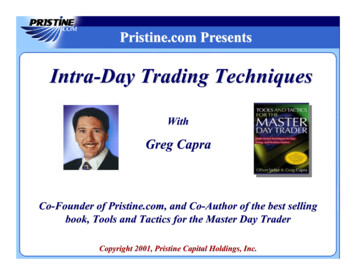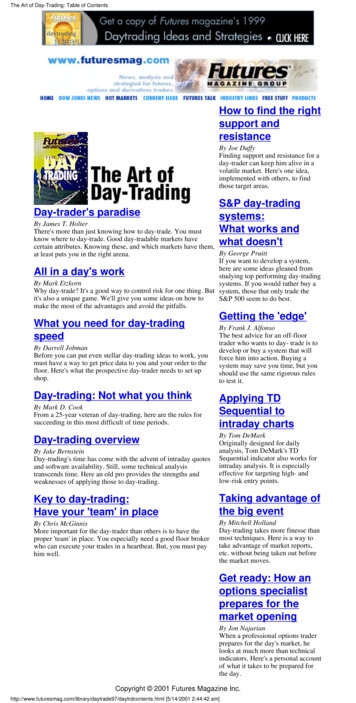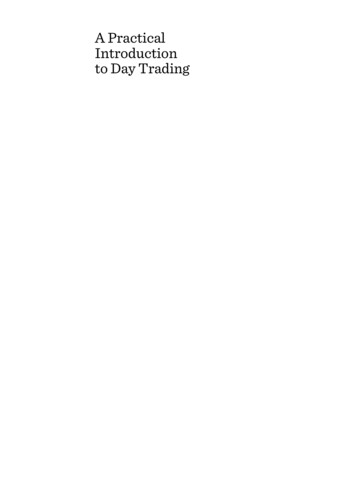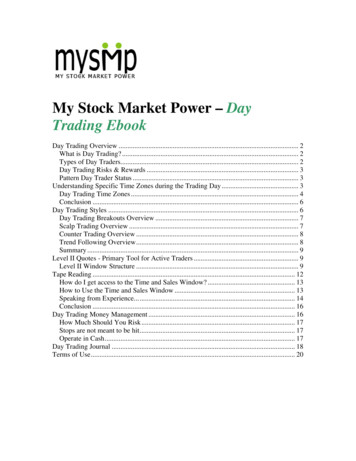
Transcription
My Stock Market Power – DayTrading EbookDay Trading Overview . 2What is Day Trading? . 2Types of Day Traders. 2Day Trading Risks & Rewards . 3Pattern Day Trader Status . 3Understanding Specific Time Zones during the Trading Day . 3Day Trading Time Zones . 4Conclusion . 6Day Trading Styles . 6Day Trading Breakouts Overview . 7Scalp Trading Overview . 7Counter Trading Overview . 8Trend Following Overview. 8Summary . 9Level II Quotes - Primary Tool for Active Traders . 9Level II Window Structure . 9Tape Reading . 12How do I get access to the Time and Sales Window? . 13How to Use the Time and Sales Window . 13Speaking from Experience. 14Conclusion . 16Day Trading Money Management . 16How Much Should You Risk. 17Stops are not meant to be hit. 17Operate in Cash. 17Day Trading Journal . 18Terms of Use. 20
Day Trading OverviewWhat is Day Trading?The act of buying and selling securities intra-day with the expectation of making fastprofits within minutes to hours is known as day trading. Day traders come in all shapesand forms, using mechanical tosystematic day trading systems, and canplace anywhere from one to thousands oftrades per day.Types of Day TradersBreakout Traders:Many day traders will trade momentumand focus on day trading breakoutsabove swing highs and swing lows whileothers will look to trade reversal setupsafter gaps.Reversal Traders:Counter-trend traders will look for signs that a stock is topping or bottoming out beforethey place a trade in the opposite direction. For example, reversal traders use tools suchas the TICK, TICKI, Put Call Ratio, volume, etc. to anticipate a change in trend.Range Traders:Range traders find stocks that have been trading within support and resistance levels andbuy when a stock hits support and sell when it hits resistance. Range traders will be mostsuccessful in markets that are choppy and that have no real direction.Regardless of the type of trader, the most important aspect of day trading is the disciplineto follow a set of rules and establishing your own money management principles whichyou live by.
Day Trading Risks & RewardsWith the use of margin, many day traders can leverage anywhere from 2 to 4 times thecash balance of their account. While this can become very profitable, it can also lead tomajor losses, especially for newer traders who have not established their lossmanagement principles. In reality, most of the day traders that enter the game lack thediscipline to adhere to strict rules and end up losing large amounts of money. Thesetraders can be classified as gamblers. However, a disciplined day trader can take largesums of money down if they have the appropriate systems and money management inplace.Day trading is an up hill battle for most because day traders do not only have to place awinning trade, they have to first offset the commissions before they can go into a profitposition.CommissionsIf you are day trading, commissions will be of utmost important for you to manage. Mostfull service brokers will charge a flat fee for trades while other brokers, such asTradestation, charge per share. For smaller traders who are just starting out, per sharetrading is great for practicing with smaller commission.For those of you trading with a couple thousands share blocks, a flat commissionstructure will most likely be more beneficial. The key is finding a broker who willprovide a platform which will allow the speed to execute orders and also provide for theability to decide which commission structure is best suited for your trading style. eSignalseems to partner with a few brokers that allow for this.Pattern Day Trader StatusThe SEC has put a barrier in place to protect investors which requires investors tomaintain a minimum balance in their accounts if they plan on making at least 4 round tripday trades in a 5 day period. If you plan on day trading, you will need at least 25,000 inyour account on a closing basis to continue day trading.Understanding Specific TimeZones during the Trading DayHaving a successful trading career not only depends on the trading system or style thatyou use but also depends on other intangibles, such as day trading time zones.Understanding the market dynamics during different times of the day will take yourtrading to the next level.
Think about your trading history and notice if you see a pattern in the different daytrading time zones in relation to winning and losing trade percentages. What a day tradermust understand is that even if a chart has a great setup, the time at which the trade isplaced may be in a day trading time zone which typically starts a countertrend move. Forexample, many traders who day trade breakouts will be far more successful during thefirst two hours of the day than any other timeframe during the day. Typically breakoutattempts will fail and reverse which will only serve to frustrate the trader and cause youto doubt your approach to trading.Let's now take a look at the different time zones and understand the general marketdynamics during each time zone.Day Trading Time ZonesThe opening bell - 9:30am to 9:50amThe first 20 minutes of the day are the most volatile of the trading day. While this is themost dangerous day trading time zone, it can also provide to be the most lucrative if youunderstand how to trade in this time frame. It is usually recommended that novice tradersstay out of this zone and wait for the imbalances created from overnight news or earningsreleases to settle down. Many technical indicators do not work well in this time frame asthe volatility is too strong. In most cases, volume will also be the highest of the dayduring this time.The Morning Reversal- 9:50am to 10:10amThe first reversal zone of the day begins at around 9:50am and lasts for 20 minutes. Thisis a very important period of the day for day traders. I look for this time zone to put oncontinuation trades. For example, a stock may gap down by 10% on the open and thenbounce for 10 to 15 minutes coming into this time zone. However, this is where daytraders will look for a reversal of the bounce and a continuation in the primary trend.Once the dust has settled from the opening bell, you will be able to more clearly see whatthe traders in this security will want to do. Volume will drop off a little bit compared tothe open but will still be very high during this day trading time zone. This time period ismy favorite for trading as the price stability returns to the market but volatility is stillpresent for profitable trading. In strongly trending markets, reversals may be small ornon-existent
Low Risk Trading - 10:10am to 10:25amDuring this day trading time zone, volatility shrinks again and you want to look for cluesin the Dow, S&P, and Nasdaq as to the direction that the market wants to take. This is anopportune time for bigger traders to move the market the way they choose. Watch thetape of the stocks that you track for any indications of direction.Decision Time - 10:25am to 10:30amThe market will be settled for the most part and most of the days volatility will havepassed. There may have been a few reversals in the first hour but during this small zone,many traders will cash out of profitable positions and finish the day while others willposition themselves for the next move in the market. I look at this period as a time forconsolidation and preparation. The move following this day trading time zone can lastuntil lunchtime.Final Move of the Morning - 10:30am to 11:15amThis time zone will be the final major time zone as far as morning trading is concerned. Itis safer in relation to the other zones in that technical indicators such as the slowstochastic or RSI will have a more pronounced effect than some of the earlier time zones.Be careful near the end of this range as it leads right into the lunch time hour which canstart early or start late. A rule of thumb is that the more volatile the preceding day tradingtime zones are, the greater the chance that this move will extend further into the 11o'clock hour.Go Eat your Lunch!! - 11:15am - 2:15pmLunchtime trading can be brutal. False breakouts and choppy sideways movescharacterize this time period. If you must trade, trade lightly until you have a good trackrecord of putting on winning trades in this time zone. Also, please let me know how youdo it! The risk to reward is very high here. Volume will fall out of the market as floortraders and other institutional traders will take their lunches. Don't let this time zone turnprofitable morning trading into a loss.Back to Business - 2:15pm - 3:00pmTraders will work their way back into the market during this time frame. For the mostpart, trends have been established and trading during this timeframe will provide youwith opportunities where the use of technical indicators is applicable. Remember, theCME closes at 3pm so you will see a pickup in volume due to some of the bond traderscoming into the equity and futures markets.It's GO Time - 3:00pm - 3:10pm
Bond market closes and bond traders will flood the equities markets; watch for sharpmoves in either direction. Moves can be fast and large.Use Caution & Stay with the Trend - 3:10pm - 3:25pmDuring this day trading time zone, use caution as you are approaching the 3:30pmtimeframe which tends to produce a reversal or a stall of the prior trend. During this zone,you want to stay with the trend that has been established from the 2:15pm and even3:00pm timeframe but don't getattached to the positions.Portfolio Re-balancing 3:30pm - 4:00pmI tend to recommend traders nottrade during the last half hour ofthe day. There are many funds andinstitutions rebalancing theirportfolios and it can get a bittricky. If your day trading, youonly have 30 minutes max to getout of your trade and I don't likeworking under that type ofpressure. If your an action junkieor like putting on very short term trades, the volatility is there for you to do so.ConclusionPersonally, I trade up until about 11:00am to 11:30am. The volatility in the morning fitsmy trading style. That is key; you need to understand who you are as a trader and tradeaccordingly.As you can see, the chart setup or systems that you look at are not the only factor inputting a day trade on. Remember, day trading is not absolute; it is a game of odds. Yourjob is to put the odds in your favor and by utilizing the different day trading time zonesthat we have discussed, your trading will become more consistent.Day Trading StylesThere are a number of day trading styles that make money in the market. This articleprovides an overview of multiple day trading strategies that professionals use to makemoney on a consistent basis. This article will contain the pros and cons of the followingday trading styles: (1) breakouts, (2) scalp trading, (3) counters, and (4) trend following.
Day Trading Breakouts OverviewBreakouts is the most common form of day trading styles. It involves identifying thepivot points for a stock and then buying or selling short those pivots in hopes of reapingquick rewards as the stock exceeds a new price level. Breakouts is generally the startingplace for newbie traders as it provides a clear entry level and it is a trend followingsystem.Pros of Breakout TradingBreakout trading has the potential for quick gains. When key price levels are exceeded itwill trigger stop order which gives that initial burst. The key component of a validbreakout is that volume and price accompany the move. This will increase the odds ofthe trade continuing in the desired direction. Breakouts are also easy to identify. Mosttrading platforms provide methods for tracking volatile stocks and how close they are totheir daily highs or lows.Cons of Breakout TradingBreakout trading is by far the most challenging form of day trading. For starters, thelevels where trades are placed are the most obvious to everyone regardless of theirtrading style. Think about it, no matter what system you use on a daily basis, every daytrading system factors in the highs and lows of the day. Secondly, the vast majority ofintraday breakouts fail. This doesn't mean they don't head higher a day or two later, but ifyour day trading and there is no instant follow through, odds are you are in a losingtrade. Day trading breakouts requires the most discipline as you have very little time tomake the call as to whether you are wrong or right. The inability to pull the trigger fastand consistently will mount in to huge losses.Scalp Trading OverviewScalp trading is a day trading style where a trader looks to make small gainsthroughout the trading day. This day trading style suits people who love "action" in themarket.Pros of Scalp TradingThe obvious benefit of scalp trading is the fact you are looking for very little from themarket. Another plus is that stop losses are very tight. This will allow the day trader toavoid the monthly "blunder" trade that we all have put on one time or another.
Cons of Scalp TradingScalp trading like any other form of trading requires discipline, but due to the largenumber of trades one will put on during the day, it requires an enormous amount offocus. This "all day focus" can make the trading day a tense situation and can lead tohigh anxiety for the trader. Also, people go into the business of trading for unlimitedearning potential and the idea that you do not have to slave away at a desk all day. Wellif you plan on scalp trading, kep a bottle next to your desk, because bathroom breaks areconsidered a luxury.Counter Trading OverviewCounter trading is when a trader looks for a pivot point, waits for that pivot point to betested and trades in the opposite direction. This type of trader has a personality where heor she enjoys going against the grain.Pros of Counter TradingCounter trading has a high success rate for day trading. Ask any seasoned trader and theywill tell you that intraday trading is nothing more than constant zig zags and head fakes.So, the counter trader is already up in the odds department, because they are goingagainst what the market is telling them. Another plus for counter trading is that when themarket fails it often fails hard. Day traders who are able to play morning reversals canmake a great living only trading the first hour of the day.Cons of Counter TradingWhile counter trading has a high win percentage, the losers can bring destruction to anaccount. Even if you win on 4 counter trades, if you do not cut the loser fast, a breakoutcould run away from you in a hurry. Another downside to trading counter is the nextpivot level is too far from your entry, so you will have to set some arbitrary stop limit.Since your stop is not based on an actual price point on the stock, it could get hit quiteoften. Lastly, setting your price target is also a challenge. Stocks will often appear tomake a double top, only to change course just as fast and reclaim the recent highs.Trend Following OverviewWhen most people think of trend following, the first thing that comes to mind is a longterm hold buy and hold strategy like the Turtle System. Believe it or not, there are daytraders who utilize trend trading systems. The basic method is to look for stocks that areup big in the news and then buy the pullback on these stocks after the first reaction in themorning. Lastly, the trader will place a longer moving average (i.e. 20) and sell the stockif it breaks the line.
Pros of Trend TradingTrend trading allows the trader to ride a stock for big gains. The day trader will have alimited number of stocks to trade per day, so the commissions are low for this kind of daytrading style.Cons of Trend TradingIf every trader was able to determine which stocks are going to trend all day, there wouldbe a new millionaire created every 30 minutes. No one knows at 10 am, which stocks aregoing to trend all day long. This means that at best, a trend following day trader can hopeto be right 20% of the time. While this trader could still make a killing with such a lowwin rate there are very few traders that can stick to their trading plan with such a low winrate.SummaryEvery trader is responsible for his or her success. Day trading can be a great moneymaker, but without a sound trading plan it can push you to your mental limits. The firststep in becoming a successful day trader, you have to determine which style of tradingbest suits your personality.Level II Quotes - Primary Tool forActive TradersLevel II provides the data for pending orders in the market. It displays the size of the bestbids and offers with their respective depths. Day traders use level II to gauge the directionof the market over the short-term. This article will discuss the working parts of the levelII screen based on the tools provided from the tradestation brokerage firm. While level IIwindows will look differently depending on the broker, the functionality is virtually thesame.Level II Window StructureThe level II window structure is comprised of four key components: (1) securityinformation, (2) bid ask window, (3) depth chart, and (4) bid ask orders.Security InformationThe first element of the level II window is the general market information for thesecurity. This information will include the symbol name, direction of the bid tick, lastprice, and net change. As the bid for the security changes, the arrow will shift up anddown and from red to green. The last price is the last recorded price for the security.
Finally, the net change represents the total dollar amount change for the security from theprevious day's close.Bid Ask WindowThe bid ask data contains the current bid ask prices for the security. This data has fourcolumns: (1) price, (2) depth, (3) size, and (4) spread). The price in the bid ask windowdisplays the current bid by the asking price. The depth represents the number of orders atthe given price. So, if you have 3 * 1 then there are 3 buy offers for every 1 sell. The sizeshows you the actual size for the bid and ask orders. So, if you have 1000 * 100, thatmeans there are traders attempting to buy a 1000 shares at the given price, while there isonly 100 shares at the sale price. The spread represents the difference between the bidand ask. The tighter the spread, the better. Day traders should look to trade stocks withhigh volume and close spreads.Depth ChartThe depth chart is the visual representation of the orders and their respective size. Thecolor of the graph in the depth chart, will match the color of the bid ask data. If you areattempting to go long, you will want to see the size and speed of the bars on the left sideof the depth chart to be larger than the bars on the right. This implies that there are morebuyers in the market.Bid Ask OrdersThe bid ask orders displays all of the pending buy and sell orders in the market. There arefour components of the window: (1) ID, (2) order type, (3) size and (4) time. The IDrepresents the ECN that the order is routed through. The order type will be either the bidor ask depending on which window you are watching. The size is the size of the order.The time represents the time that the order was placed. The bid ask window is the
consolidated version of all the bid ask orders. Traders will look at all the bid ask orders inthe level II window, to gauge the momentum and to see how many orders are at aparticular level.
Example of Level II WindowTape ReadingFrom my experience in day trading over the last few years, my most valuable toolbecame the time and sales window, aka. the "Tape". The time and sales windowbasically shows the trader detailed information regarding the order flow for a particularsecurity. The time and sales window provides details on each of the trades that have gonethrough for that security, such as: Time of Trade, Price, Size of order, and condition oforder. Depending on the trading platform, you will have other data points available toyou.
After mastering the message of the tape, you will be able to accurately decide when toenter and exit a trade.How do I get access to the Time and Sales Window?There are few brokers in the marketplace that offer the time and sales window to theircustomers. Typically, only trading platforms which are suited for day traders offer thisoption. I use Tradestation and as you can see in the image above, provides all the keyelements that will allow one to effectively read the tape.How to Use the Time and Sales WindowI am a very big believer that there are two truths in trading stocks. One is price and theother is volume. Tape reading involves both; and if used correctly, dramatically increasesthe odds of your trading working out. It does so due to the fact that your goal with tapereading is to follow the money.While some professional traders may not like to admit it, trading stocks is an odds game.Your job as a trader is to put trades on with the highest odds of winning. Trading with thetape requires trading with patience. You cannot go out and buy or short a stock because
you see the tape speeding up a bit. You need to be aware of support and resistance levelsand also combine the message of the tape with price pattern formations.Tape reading can be very fast and confusing at times and requires quite a bit of practicein order to get used to understanding the true meaning behind what you are seeing.Remember, every stock is a different story and tends to trade differently. It is wise toreview the way in which the "tape" trades for a couple of minutes before entering a trade.Reading the tape requires you to train your eyes to scan for changes in character. I wantto discuss a few of these key changes that you should take note of:Size of OrdersLets start with size. The size of the orders coming through will help you decide if there isconviction behind the price action you are seeing. When putting on a trade, you typicallywant to see a flurry of buy or sell orders which have greater than 300 to 400 shares insize. There is no hard and fast rule about this; it is more of a visual cue that your eye getstrained to recognize. Many times, I will see great technical setups in stocks that trade lowvolume. I stay away from these setups as the message of the tape is not as clear and thislowers my odds of a winning trade.Order SpeedThe speed of the orders is another key component to the message that the tape is givingyou. Typically, when stocks breakout through support or resistance levels, not only willthe size of the orders go higher but you will see the tape start to speed up. This gives youan indication that there is an interest in this stock at this level and that the interest islarger than a couple small traders buying or selling.Order ConditionOrder condition refers to which side of the bid/ask spread the trade was executed on.When we go long a stock, we want to see many orders being executed at ASK.Conversely, when we go short, we want to see orders being filled at BID. This gives us aclue as how desperate traders are to get into our out of this stock.Speaking from Experience.Above, I have reviewed a few basic principles of tape reading but I want to discuss someof lessons I have learned throughout my years of trading that I think you will find helpfulwhen analyzing the tape.Which stocks are best to trade?I have received this question many times. The answer to this question for me is simple, Ionly trade the most volatile stocks of the day. These stocks are the ones which will
provide you with strong volume and large interest from the public. They also providestrong and fast moves which you can make larger profits from. Remember, we need tosee speed in the tape and that requires a stock with public interest.Does the tape work better during specific times of the day?In my experience, the answer to this question is YES. I typically only trade the first 2hours of the day. This is when the most volatility is present in the market and also whenmost of the trending moves are made. Typically, lunchtime becomes very choppy and hasa different group of traders who are buying or selling for different reasons than the firsthour. I am not ruling out trading after lunchtime, however, my results have been less thanstellar when I attempted to do so.Tape Reading with Level 2The level 2 window provides the trader with an edge. It will show you the sizes of theorders in the market makers book. While the market makers can play games with thelevel 2 in order to fool traders, in general you want to see high bid sizes and low ask sizeswhen you go long. On the flip side, you want to see low bid sizes and high ask sizeswhen you go short or sell out of a stock. Again, its not foolproof but it adds to the odds ofyour trading winning.Exiting a tradeThis is probably the most difficult part of the trade for most traders. Tape reading helpsme get out of the trade by looking for imbalances. When I see a stock moving sharply inone direction, I will immediately look to the tape to offer clues as to when the brake padswill be applied. Again, this skill will take practice to develop. If your short a stock, keepan eye out for the bid side getting heavy and the bid/ask spread widening. This could be atell tale sign that the juice has been used up.Bid/Ask Spread at Key LevelsMake sure that stock does not have large bid/ask spreads as it approaches your entrypoints. You will not have much time to place you trade and if you are trading a volatilestock, you most likely will have to execute the orders at market. Large spreads tell metwo things; first, your risk increases significantly when the spread increases. Why?Because most times you will have trouble getting out of a stock with a large spread usinglimit orders and this can turn a small loss into a big one quite quickly. Secondly, it tellsme that there is not that much interest in the stock. If there was, the spreads would narrowand both sides would come as close as possible.Extremely High Volume StocksThere is trading high volume and then there is trading extremely high volume. I try andstay away from stocks that trade, for example, 30 or 40 million shares as the message of
their tapes can be a bit confusing at times if your a beginner. You may see 14 orderscome through at bid with large sizes but that may not mean as much as if the stock wastrading less volume. Remember to always keep everything in context. If your stock tradesgigantic volume, you should expect a different kind of tape action.Make price prove the pointUp to this point, we have discussed order size, speed, and condition. While these are allkey components of the tape, you must let price prove the point. For example, if you arelooking to short a stock at 54 and there is strong order flow selling at bid at that level,my experience has shown me to wait for that level to break. If it does not, you may beinvolved in a trap that was made to get the weak traders out and then take the stock in theopposite direction.Don't let your ego get in your wayOne of the biggest mistakes that I see many traders making is that they get attached totheir positions. In an effort to appease their ego's, they tend to take a trade and stick withit until they are right. Remember, day trading is an extremely fast game and if you do notreact with speed, you will be left in the dust. When you make a decision based on thattape action and the stock does not go in your favor relatively quickly, odds are that youare in a bad trade.FocusIt is extremely important to have utmost focus when
What is Day Trading? The act of buying and selling securities intra-day with the expectation of making fast profits within minutes to hours is known as day trading. Day traders come in all shapes and forms, using mechanical to systematic day trading systems, and can place anywhere from one to thousands of trades per day. Types of Day Traders

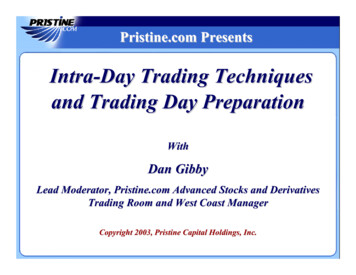
![Welcome [dashdiet.me]](/img/17/30-day-weight-loss-journal.jpg)
